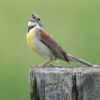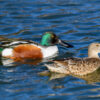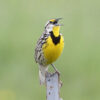
Great Egret, Ardea alba
Bill Rowe
The handsome Great Egret, our second-largest heron after the Great Blue, is the symbol of the National Audubon Society, reflecting its early achievements (over a century ago) in securing protection for this species and other water birds that were endangered by the lucrative trade in plumes for ladies’ hats. From a low point around 1910, the population of Great Egrets rebounded, and their range expanded up the Atlantic coast and inland as well. Nowadays they are holding their own despite our continuing loss of wetlands; this may mean that the egret is simply more versatile and adaptable than some other water birds. Even in areas where they seldom nest (like Missouri), egrets will locate good feeding areas, including temporary ones like flooded fields, and will show up there by the hundreds. An egret is always an impressive sight, standing motionless at the water’s edge or walking slowly through the shallows in its search for fish, frogs, and other animal life, which may even include small birds and mammals. It is also impressive in flight, with its long neck pulled back in a typical heron-curve and its slow, steady wingbeats—a sight that you could see anywhere now, even over the city or the suburbs.
IDENTIFICATION: The Great Egret is by far our largest white heron, with a long, slender, kinked neck. In a binocular view, its long yellow bill and black legs will quickly certify that your bird is this species and not the smaller Snowy Egret, Cattle Egret, or immature Little Blue Heron.
ST. LOUIS STATUS: A worldwide species, the Great Egret can be seen around our area in numbers from April through October, although they don’t actually nest here very often. When they do, it is typically in colonies, with the nests built close together in a grove of trees, often among other species; these are called heronries or, less accurately, rookeries (named for the Rook, a colonial-nesting crow found in Eurasia). Surprisingly, a heronry has been found in a residential neighborhood in the City of St. Louis; it contains several species including Great Egrets.
In our area, egrets reach their highest numbers in late summer and early fall, when there is an influx of post-breeding birds from farther south. After a major flood, they may show up by the thousands. The cooling temperatures of October and November send them south again, but occasional hardy individuals may stick around into December or even stay through the winter.
Learn more and listen to the unmusical voice of the Great Egret here.




